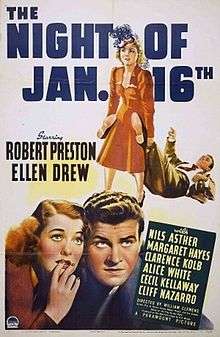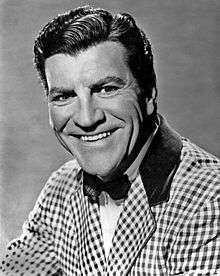The Night of January 16th (film)
| The Night of January 16th | |
|---|---|
 Movie poster | |
| Directed by | William Clemens |
| Screenplay by |
|
| Based on |
Night of January 16th by Ayn Rand |
| Starring | |
| Music by | Gerard Carbonara |
| Cinematography | John J. Mescall |
| Edited by | Ellsworth Hoagland |
Production company | |
Release dates |
|
Running time | 80 minutes |
| Country | United States |
| Language | English |
The Night of January 16th is a 1941 American film directed by William Clemens, based on a play of the same name by Ayn Rand. The story follows Steve Van Ruyle and Kit Lane as they investigate the apparent murder of Lane's boss, in an attempt to clear her as a suspect.
Plot
Steve Van Ruyle (Robert Preston) is a sailor who inherits a position on the board of a company headed by Bjorn Faulkner (Nils Asther). The board is concerned to discover $20 million has disappeared from the company's funds, and demands answers from Faulkner. That night Faulkner meets with a man called Anton Haraba, and is apparently thrown from his penthouse balcony to his death. Moments later, Faulkner's secretary, Kit Lane (Ellen Drew), enters the penthouse, leading police to arrest her for Faulkner's murder. Van Ruyle takes it upon himself to investigate the crime. Suspecting that Lane and Faulkner were embezzling the money together, he pays her bail so he can question her about the situation. They find Faulkner's diary, and the entries lead Van Ruyle to believe Lane is innocent. The district attorney (Paul Stanton) doesn't agree, and Lane goes to trial.
Van Ruyle attempts to prove Lane's innocence with fake evidence, but his ruse is discovered. The two flee with evidence from Faulkner's apartment, which they use to track down the mysterious Haraba. They trace him to a hotel in Havana, Cuba, where they discover that "Haraba" is a pseudonym being used by Faulkner himself, who has faked his own death. When Faulkner takes Lane captive, Van Ruyle rushes with police to Faulkner's room to rescue her. Faulkner is arrested, and Van Ruyle and Lane decide to get married.
Cast
- Robert Preston as Steve Van Ruyle
- Ellen Drew as Kit Lane
- Nils Asther as Bjorn Faulkner
- Clarence Kolb as Tilton
- Willard Robertson as Inspector Donegan
- Cecil Kellaway as Oscar, the Drunk
- Donald Douglas as Attorney Polk
- Paul Stanton as the District Attorney
- Margaret Hayes as Nancy Wakefield
Production

The movie rights to the play were initially purchased by Metro-Goldwyn-Mayer (MGM) in October 1934 as a possible vehicle for Loretta Young. They hired Rand to write a screenplay, but the project was scrapped.[1] After MGM's option expired, Al Woods, who was producing the play on Broadway, considered making a movie version through a production company of his own.[2] Instead, in 1938 RKO Pictures bought the rights for $10,000, a fee split between Woods and Rand. RKO looked at Claudette Colbert and Lucille Ball as possibilities to star, but they also gave up on the adaptation. The rights were resold to Paramount Pictures in July 1939 for $35,000.[3][4][5]
Rand did not participate in the production at Paramount. Three other writers (Delmer Daves, Robert Pirosh, and Eve Greene) were brought in to prepare a new screenplay.[1][6] Paramount planned for the film to star Barbara Stanwyck and Don Ameche, who was to be loaned out by 20th Century Fox, where he was on contract. Ameche refused to take the part, which delayed the start of the production, causing Stanwyck to drop out also.[7] As a result, Ameche was suspended for two weeks by 20th Century Fox and sued by Paramount for $170,000 in damages. Paramount considered Paulette Goddard and Ray Milland for the roles before finally casting Drew and Asther.[8][9][10]
The production used the working titles Private Secretary and Secrets of a Secretary, but the movie was released in 1941 as The Night of January 16th, following the title of the play.[3] The play took place entirely in a courtroom, and its best-known feature was that it used a jury selected from members of the audience, who would decide the defendant's guilt or innocence at the end. This feature was impossible to reproduce in a movie, so the new screenplay altered the plot significantly, focusing on Steve Van Ruyle, a character that did not exist in the play. Unlike the play where Faulkner is already dead, in the movie he appears as a living character who is then apparently murdered. The name of the prime suspect, Faulkner's assistant, was changed from Karen Andre to Kit Lane, and the action is not focused on the courtroom.[5][6][11] Rand claimed only a single line from her original dialog appeared in the movie, which she dismissed as "cheap, trashy vulgarity".[12]
Reception
The film received little attention when it was released, and most of the reviews were negative.[13] A review in Variety praised Drew's performance, but described the direction as "heavyhanded" and the plot as involving "an unbelievable set of coincidences".[14]
See also
- The Match King, another movie inspired by the same events as the play this movie is based on
References
- 1 2 Heller 2009, pp. 77–78
- ↑ "Nazimova to Play Tonight". Los Angeles Times – via ProQuest (subscription required) . Mar 16, 1936. p. 13.
- 1 2 "Night of January 16th (1941): Notes". TCM.com. Retrieved May 23, 2014.
- ↑ Heller 2009, pp. 105, 469
- 1 2 Wilt 1991, p. 113
- 1 2 Weiler 1941
- ↑ Churchill 1940, p. 22
- ↑ "New Tracy Film Next at Capitol". The Brooklyn Daily Eagle. 99 (54). February 24, 1940. p. 18 – via Newspapers.com.

- ↑ "Don Ameche and Studio End Battle over Part". The Ogden Standard-Examiner. 70 (270). UP. March 21, 1940. p. 4B – via Newspapers.com.

- ↑ "Don Ameche Sued for $170,000". The Ottawa Evening Journal. 55 (103). AP. April 10, 1940. p. 15 – via Newspapers.com.

- ↑ "Night of January 16th (1941)". TCM.com. Retrieved May 21, 2012.
- ↑ Rand 1971, p. 14
- ↑ Johnson 2005, pp. 55–56
- ↑ "Film Reviews: Night of Jan. 16". Variety. 144 (1). September 10, 1941. p. 8.
Works cited
- Churchill, Douglas W. (February 21, 1940). "News of the Screen: Ameche Suspended From Salary for Refusal to Take Film Part-Man From Dakota Opens Today". The New York Times. 89 (29,978). p. 15.
- Heller, Anne C. (2009). Ayn Rand and the World She Made. New York: Doubleday. ISBN 978-0-385-51399-9. OCLC 229027437.
- Johnson, Donald Leslie (2005). The Fountainheads: Wright, Rand, the FBI and Hollywood. Jefferson, North Carolina: McFarland & Company. ISBN 0-7864-1958-X. OCLC 56617298.
- Rand, Ayn (1971) [1968]. Night of January 16th (paperback ed.). New York: Signet. ISBN 0-451-12530-4. OCLC 152404469.
- Weiler, A.H. (December 19, 1941). "Movie Review: The Night of January 16th". The New York Times.
- Wilt, David E. (1991). Hardboiled in Hollywood: Five Black Mask Writers and the Movies. Bowling Green, Ohio: Popular Press. ISBN 0-87972-525-7. OCLC 24154116.